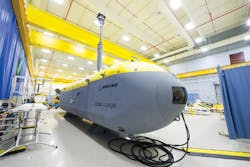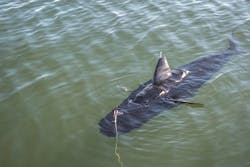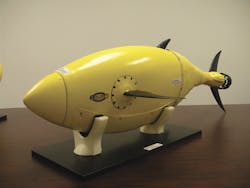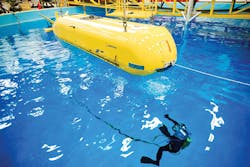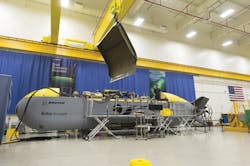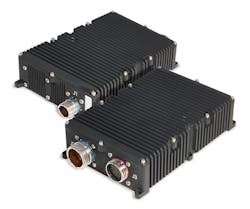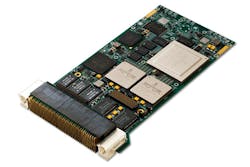New designs in autonomous submersibles for military applications are setting new standards for long-endurance power storage and stealthy propulsion for surveillance, mine warfare, and anti-submarine warfare operations.
By J.R. Wilson
Unmanned underwater vehicles (UUVs) have been compared to cats' whiskers as extended sensors, although they could more accurately be compared to catfish barbels, whisker-like feelers loaded with tiny taste buds and olfactory sensors to help the fish survive in dark, murky waters.
UUVs are the undersea cousins of unmanned aerial vehicles (UAVs), but are running two decades or more behind UAVs in development and military implementation - a situation U.S. Navy officials say is about to change.
"The key technologies for UUVs in general really can be categorized in autonomy and power, which have had the most focus in the last few years," says Dan Tubbs, deputy director of sea & land at Boeing Phantom Works in Huntington Beach, Calif. "Battery power is one of the keys, but other things are being looked at by ONR [Office of Naval Research] and other companies, such as fuel cells, aluminum power capability, air-independent power, etc.
"You see a lot of AUVs [autonomous undersea vessels] in oil and gas today, where a commercial surface ship will launch a UUV to traverse the sea floor and bring data back," Tubbs continues. "In the military world, work is going on with Knifefish [General Dynamics], which would use UUVs to do mine reconnaissance on the sea floor. That and other programs are really doing recon, but other work is being done to keep people out of dangerous locations, such as disabling [underwater] mines."
A key difference between military UAVs and UUVs is communications, Tubbs adds: "UAVs have evolved rapidly in direct communication with people on the ground while flying. For UUVs, there is no real high-bandwidth communications path for that kind of direct link. So while AUVs will follow, to a large degree, the path forged by UAVs, there still needs to be significant work on how to talk to those vehicles, especially in terms of weaponized UUVs. ISR [intelligence, surveillance, and reconnaissance], whether below water or on the surface, is absolutely viable for UUVs today, although they still have to overcome communications limitations."
The counter-UUV challenge
A small business innovation re- search solicitation last year gave a detailed Navy description of the requirements for advancing and deploying next-generation UUV technologies to counter emerging threats, including enemy UUVs:
"New or improved sensing concepts and technologies are needed to better recognize the presence of UUVs operating in ports and harbors, particularly in the proximity of U.S. Navy ships and submarines," the solicitation stated. "The maturity and proliferation of UUVs throughout the world is presenting an emerging challenge for force protection in harbor environments. It is important to counter sensor-laden units that do not present a direct threat, but an armed UUV presents a particularly compelling challenge. The mobility of UUVs limits the effectiveness of traditional mine countermeasures, like change detection."
Ships tied up in harbors are stationary and inviting targets for UUV sensors or weapons. "The stationary nature of the assets that are being protected in harbors allows for slow and deliberate approaches by enemy platforms," the solicitation states. "Current strategies for detecting and classifying UUVs employ systems that were originally designed to detect combat swimmers and scuba divers. A number of these systems have demonstrated some capability against UUV targets that were presented in a controlled research environment, but the typical warning ranges do not provide a completely satisfactory response window. It is envisioned that a multimodal layered approach has the potential to significantly increase the average response window available to counter UUV approaches to U.S. Navy assets."
Given the ubiquity of and nearly universal reliance on UAVs after 15 years of constant combat development, it may be hard to remember the scant military interest in unmanned aircraft decades ago. Military interest in UAVs did not start rising until scientists at the U.S. Defense Advanced Research Projects Agency (DARPA) in Arlington, Va., noted Israeli efforts to remove human pilots from dangerous reconnaissance missions. As a result, DARPA began a series of small research programs.
It has been a similar challenge for UUVs and their proponents, especially given many years of predominantly land warfare and air-dominance operations. UUV interest revived, however, in the wake of a deadly small boat terrorist attack on the destroyer USS Cole in the Yemen harbor at Aden in 2000.
Growing interest in UUVs
UUV interest later increased with feigned Iranian attacks on U.S. ships in the Persian Gulf, constant threats against naval and commercial shipping by North Korea, the growing U.S. face-off with China in the Western Pacific, pirates off the coast of Africa, and even the use of relatively primitive semisubmersibles by drug smugglers off U.S. coasts in the Atlantic, Pacific, Caribbean, and Gulf of Mexico.
"Unmanned capabilities have a high value in removing the risk to humans, but the success of these technologies in UAVs has made it a much more mainstream option for UUVs," notes Aaron Heisler, mechanical engineering manager at embedded computing specialist Extreme Engineering Solutions (X-ES) in Middleton, Wis. "Regardless of the mission - SIGINT, offensive, communications - once we have the capabilities to perform those without putting humans at risk, our regional influence will not be restricted by very expensive manned platforms.
"There has been a very significant interest in the latest processors for prepackaged small-form-factor solutions, the goal being to improve the prime's capability, cost- and schedule-wise," Heisler continues. "Expectations following creation of N99 [Unmanned Warfare Systems Directorate] to push these technologies in this application space is for significant advancement and more military and government interest in UUVs. I think we're approaching the threshold where UAV success and widespread acceptance are opening the door for UUVs. The creation of the new office should ensure those technologies will see significant investments in the future."
DARPA continues to lead military research of future technologies and missions for unmanned marine vehicles that operate on the surface or under the water. One of DARPA's high-profile research programs is the Anti-Submarine Warfare [ASW] Continuous Trail Unmanned Vessel (ACTUV) program to develop an unmanned surface vessel (USV) optimized to track quiet diesel-electric submarines persistent to limit the submarine's tactical capacity for surprise.
"We're looking for test-ready, multi-sensor approaches that push the boundaries of today's automated sensing systems for unmanned surface vessels," DARPA Program Manager Scott Littlefield says. "Enhancing the ability of these kinds of vessels to sense their environment in all weather and traffic conditions, day or night, would significantly advance our ability to conduct a range of military missions."
Next is the DARPA Blue Wolf to develop UUVs with inherent operational and tactical advantages like stealth and surprise. Blue Wolf also is an attempt to introduce fundamentally new UUV designs.
Overcoming size and weight
Today UUV size, weight, and volume are constrained by their launch and recovery systems. UUV range, moreover, is limited by the amount of energy available for propulsion and the power necessary to maintain underwater speeds. Current state-of-the-art energy sources are limited by safety and certification requirements for host platforms.
In September 2015, the Naval Undersea Warfare Center (NUWC) in Keyport, Wash., awarded $2.5 million Blue Wolf contracts on behalf of DARPA to Boeing Defense, Space & Security in Huntington Beach, Calif., and to Lockheed Martin Mission Systems and Training in Riviera Beach, Fla. They joined the Charles Stark Draper Laboratory in Cambridge, Mass., which won a $3.7 million Blue Wolf contract, and Applied Physical Sciences (APS) Corp. in Groton, Conn., which won a $3.1 million Blue Wolf contract.
DARPA also is working on the Hydra Distributed Undersea Network to create a force multiplier that enables rapid, scalable, and cost-effective deployment of capabilities much faster and more cost-effectively. U.S. Navy assets must cover vast regions of interest around the globe even as force reductions and fiscal constraints continue to shrink fleet sizes. To maintain an advantage over adversaries, the Navy must project key capabilities in multiple locations at once, without the time and expense of building new vessels to deliver those capabilities.
"The climate of budget austerity runs up against an uncertain security environment that includes natural disasters, piracy, ungoverned states, and the proliferation of sophisticated defense technologies," DARPA's Littlefield says. "An unmanned technology infrastructure staged below the ocean's surface could relieve some of that resource strain and expand military capabilities in this increasingly challenging space."
Rear Adm. Mathias Winter, chief of the Office of Naval Research (ONR) in Arlington, Va., and Navy Secretary Ray Mabus also have touted development of a UUV that can operate underwater for long periods without refueling.
The program-of-record in that regard is the Large-Displacement UUV (LDUUV), a naval prototype that would use new energy technologies to enable months of operations in the littorals without returning to port or being directed from a mothership. According to ONR documents, "new energy sources for UUVs will increase the current energy density significantly, allow for quick recharge or refueling, operate at an acceptable cost level, and enable pier-to-pier operation with months of endurance."
UUV mothership
While Boeing has been one of the contractors bidding to be prime on the LDUUV, the company's Phantom Works in Huntington Beach, Calif., has moved ahead using company money to develop just such a vessel: the Echo Voyager, which rolled out on 10 March 2016 and is scheduled to begin sea trials off the California coast this summer.
"The Navy is changing its acquisition approach and we're waiting to see how that plays out," says Boeing's Tubbs about LDUUV, but adds Boeing is moving forward with its in-house-funded program. "Around 2010, we embarked on developing a concept for something that could change the paradigm on how UUVs operate in terms of increasing their legs so they could be out for weeks or months at a time instead of only two or three days. And removing UUVs from the tyranny of the host platform, which limits UUV size as well as redundancies and fault tolerance onboard.
"With invested Boeing money to change the UUV paradigm, how UUVs are utilized in commercial, military, and science markets, to provide a change to the commercial off-the-shelf (COTS) curve on how to use UUVs for important missions," Tubbs says. "We believe we have taken a large step. We've also done work on how to support the UUV in the field; Echo Voyager is designed so it is supportable and maintainable by folks on the pier without being pulled from the water, much as you would a manned submarine, which makes it much more economical to utilize."
With its hybrid rechargeable power system and modular payload bay, the 51-foot Echo Voyager follows earlier Boeing UUV designs, such as the 32-foot Echo Seeker and 18-foot Echo Ranger, but is the company's first to offer fully autonomous, long-duration capability with sufficient payload space for a wide range of missions.
While it is too early for customer contracts on the Echo Voyager, Tubbs says if they received an order today, they could deliver the first vessel in 24 months or less and, without significant additions to the facility, produce at least two a year at Huntington Beach.
Master plan for UUVs
While the current version of "The Navy Unmanned Undersea Vehicle Master Plan" is classified, the publicly released 2004 version listed 11 mission categories for UUV operations: intelligence, surveillance, and reconnaissance; mine countermeasures; anti-submarine warfare; inspection/identification; oceanography; communications/navigation network node; payload delivery; information operations; time-critical strike; barrier patrol for homeland defense and force protection; and sea base support.
Accomplishing so wide a variety of missions will require the same kind of developmental work that has gone into UAVs since the terrorist attacks of 9/11, with many of those able to transfer directly or with only minor modifications to UUVs.
One potential use for the UUVs would be to act as an undersea warning and control system - a submersible version of the U.S. Air Force Airborne Warning and Control System (AWACS) surveillance and air traffic and control system jet. "A UUV with an AWACS capability for subs to surface ships is a possibility, as is expanding communications, where multiple services engaged simultaneously may not always work," says Joe Eicher, business development manager at embedded computing specialist Kontron in Poway, Calif.
Eicher also cites the Northrop Grumman Battlefield Airborne Communications Node (BACN) as a future candidate for UUVs. The BACN, he says, "can serve as a translator between communications technologies. You can see a UUV designed to bridge gaps in hardware and feature interoperability in a similar manner. Battery power will be a very important part of the future of UUVs. If the battery runs out before it gets home, it might sink and become a target for enemy recovery. So intelligent power management would have to be employed in a UUV, including knowing when to return to base."
One issue with UUVs continues to be size. "These vehicles have been around for some time on the commercial and research sides, but are a relatively recent endeavor on the military side to develop on a scale large enough to be of use to the Navy," Kontron's Eicher says.
"It seems like a natural evolution from all the work that has been done on UAVs, but developing underwater capability for military use is relatively new," Eicher adds. "There have been proof-of-concept efforts, such as Echo Ranger, but I think we're now moving beyond the point where we showed something to the Pentagon, only to see it mothballed, to actually moving forward with development and deployment."
Open-systems electronics
A new entrant into the UUV market is North Atlantic Industries (NAI) in Bohemia, N.Y. For the past year NAI engineers have been adapting their company's boxes, boards, and I/O for a classified mine-hunting UUV program. Their overall UUV efforts include onboard equipment to analyze sensor data, gauge strain, and measure water temperature, says Lino Massafra, NAI's vice president of sales and marketing. While most of that data is used on and by the UUV, NAI also can provide Ethernet communications back to a manned vessel.
"The entire architecture we're offering for the UUV market is the same as we offer for custom-on- standard-architecture [COSA] for all our customers," Massafra explains. "That fits in nicely with the integrated modular architecture some U.S. Department of Defense people have been resisting but now are beginning to understand the threats are changing, almost monthly, and if it takes five to 10 years to bring a new program out, we don't have that kind of time anymore."
NAI engineers capitalize on the company's expertise in modular electronics architectures to adapt components and subsystems to UAV applications. "A modular architecture helps us pick and choose how to configure a system and, with very little if any non-recurring engineering, we can turn things around and populate systems with specific I/O functions and processing to meet specific requirements as part of our accelerated time-to-market," Massafra says. "That's our COSA approach. Customers can do everything in-house, which is very expensive, or go full COTS, which makes you dependent on others. We bring together the best of both worlds, with a custom solution using COTS products under COSA."
Component companies such as NAI and Kontron must maintain a constant vigil on the emergence of new chips with higher efficiency, higher channel count, better resolution, and higher speed that can be used in future products.
"The key thing is there are only a limited number of configurations in a fixed-box design as opposed to our COSA approach," Massafra notes, adding a warning that the federal government may be making it easier for other nations to close the technology gap, including UUVs. "What's preventing the U.S. from moving forward is budget cuts and so many rules and regulations being put in place that limit the innovative aspects of small businesses such as ours," he asks. "They may only want to buy five pieces from us off-the-shelf, but then when they want more they are asking us to justify earned value management and a lot of other paperwork."
Homeland security concerns
ONR and the U.S. Department of Homeland Security Science & Technology Directorate (DHS S&T) are supporting the advancement of two related products at the Boston Engineering Corp. Advanced Systems Group in Waltham, Mass.
The first is GhostSwimmer, a stealthy biomimetic UUV for military missions like surveillance, mine countermeasures, port security, and similar defense and homeland security initiatives. The other is BIOSwimmer, a biologically inspired UUV built to resemble a tuna fish. It has broad commercial and homeland security applications like inspecting ships, securing ports, and marine maintenance.
"Unmanned systems directly support our sailors, making their jobs easier, more efficient, and, ultimately, a more effective combat team," says Navy Rear Adm. Robert Girrier, director of the Navy's N99 office of unmanned weapon systems.
"As unmanned systems continue to come online and mature, we're changing how we think and how we operate, so we're not just reacting to the challenges we face today, but focusing creativity and initiative to ensure we prevail in the future," Girrier says. "I remain committed to developing and integrating unmanned systems into our broader warfare areas."
A wide range of companies are looking to get a piece of what is seen as a major growth market in the coming decade, not only vessel manufacturers, but sensor, power, communications, and other mission-support technologies and components. German-based Kontron AG, for example, offers control, guidance, sonar, and other components to UUV primes.
"The common thread of interest on anything unmanned is safety critical," says Kontron's Eicher. "If you have a zone where you don't want to risk collisions, you want the UUV to operate in a safety-critical mode. Anytime you have any kind of unmanned vehicle making decisions as it moves along, you want to be very, very sure it won't damage anything or risk lives. That has to be a mechanism that not only detects a problem, but has a fallback position, such as shutting down and floating to the surface.
"There also are questions about throughput - how many cores can we provide, what is our thermal efficiency - so it meets their envelope for environmental operability," Eicher continues. "Can it withstand the pressures in which it operates? What is the total load of the processor? How do we feed that out? The Navy also will want to maintain very tight-loop security on UUVs so the enemy cannot employ any countermeasures to usurp functionality or spoof us with erroneous data.
"UAVs have been around a long time now and more effort has been applied to making future generations stealthy," Eicher says. "That also seems a logical step for UUVs, applying sister technologies similar to UAVs."
Networking UUVs
Today's UUVs typically receive control via data link from a manned surface ship or submarine. Due to the relatively short range of underwater communications, finding a UUV could make it easier to backtrack it to that vessel, no matter how stealthy it might be.
That is one benefit of long-endurance autonomous undersea vessels (AUVs), such as the proposed LDUUV or Boeing's Echo Voyager, which operate independent of and far from their controllers.
At a 29 January 2016 event cohosted by the U.S. Naval Institute and the Center for Strategic and International Studies, Girrier described how his new office fits into the Navy's other staff centers - Amphibious Warfare Directorate (N95), focused on ship-to-objective maneuver; Surface Warfare Directorate (N96), implementing a distributed lethality concept; Undersea Warfare Directorate (N97), working to achieve undersea dominance; and Air Warfare Directorate (N98), which will build the airwing of the future.
"It is the future. It is not at the expense of, it is not in replacement of - it is a complement to [the other warfare directorates]," Girrier told the conference. "The domain is the enabler; the domain is where the vehicle [operates], where the 'what' plays out. It's increasingly about 'how' and 'how fast' for that larger end-state. So I think there's a greater realization of cross-boundaries.
"We are living in a world that is connected more than ever with the surge of technology and rapid information sharing. We are also living in an increasingly dangerous world with contested regions on the sea, in the air, under the sea, and in cyberspace. My job, drawing on fleet experience, is to see how unmanned systems and technology can help solve problems we face in contested regions around the world. How can unmanned systems help leverage the capabilities of our ships, submarines and aircraft?"
